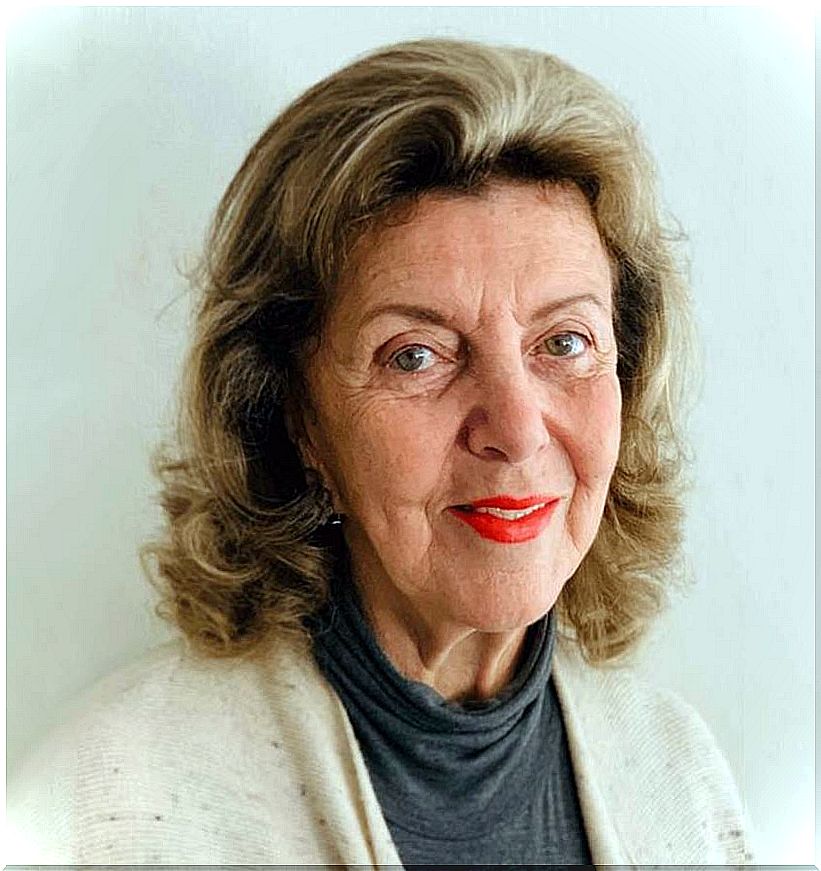“Children Should Not Be Labeled, But Rather Work With Their Spirit”
Montessori Method researcher, travels the world showing how to help children develop their full potential so that they can be happy.

Trainer and researcher of the Montessori Method, she is 80 years old and seems like a girl excited about the new life. Silvia C. Dubovoy teaches her students and future teachers to observe boys and girls without preconceived ideas or expectations, but from pure presence, to help them live in alignment with their nature.
“My goal is to offer a look at some of the obstacles that a child faces in our world today, which cause deviations in their personality and their healthy, positive and optimistic way of seeing the world.”
“I show how to observe them being empty of everything and avoiding inducing or influencing them with our way of thinking and acting in order to surprise us with what appears spontaneously from within,” says Dubovoy, doctor in psychology and member of the Research Committee of the Association Montessori Internationale (AMI) that gives training at different universities in Spain, Mexico, Canada and the United States.
In addition, when she had already fallen in love with the educational proposals of Maria Montessori, she established a deep friendship with Carl Rogers, one of the great humanist philosophers who also defended an education based on the life experience of the student of whom she was a student and collaborator.
Interview with Silvia C. Dubovoy
–Why is the Montessori Method so successful today?
–Because the Montessori method applies what therapists are recommending to parents who have problems with their children. Because it is urgent to stop labeling children and start working with their spirit. You cannot continue talking about deficits: the moment you find something of value in the person and you focus on it, the rest no longer matters. And everyone has a value.
Nature makes us different, but society calls some of us disabled and others not.
Society does not support people who have physical or mental problems, it limits itself to separating them when healing involves creating groups of people of different types. Boys and girls must be with different boys and girls in order to learn from each other. However, there are a series of labels such as autistic, asperger and ADD that make this integration difficult.
–What to do with children who have been diagnosed with ADD?
– It gives me the feeling that it is a disorder that somehow affects us all, because we all do more than one task at the same time and sometimes it is not so much that we suffer from a lack of attention, but rather that we force ourselves to paying attention to too many things and people at the same time. Today there are so many stimuli that children want to be attentive to everything and this leads to a lack of concentration. To this is added the education that we have that makes children very bored.
Who might be interested in following textbooks in a world where all the information you need is found on the Internet?
–How to build a more stimulating educational model then?
–My task is to raise awareness of the need to observe the internal manifestations of boys and girls without prejudice, without preconceived ideas, without expectations. It is simply a matter of seeing them for the wonderful beings that they are. Children are closer than we are to what is the essence of humanity. And as we are acting with them today, we are not paying attention to what they are, we do not really know our children because we do not let them show or express what they carry inside.
A child will only show his true nature if he is looked at cleanly.
We do not realize that they are wise. They are born with 86 billion neurons, they have many more neurons than we do that at 15 years of age we have already lost half the neurons with which we were born. This large number of neurons allow them to adapt to so many things! However, we do not give them the opportunity to develop their full potential. Someday the immense sensitivity that little ones have to absorb on a mental level, but also on an emotional level and physical movement, will be recognized. I am passionate about the Montessori Method because it is based on the great potential that resides in each child and focuses on developing it.
–What are the foundations of the Montessori Method?
-Your vision of the child is fascinating. Maria Montessori tells in one of her books that she was conducting an educational experiment with 60 children from 3 to 6 years old in a very poor neighborhood in Rome and one day she sat down and asked them: Who are you? And this is the big question to ask yourself when we are working with children. That is why I invite you to observe the emotion of children as they always work from the here and now without bringing the past to this observation and without thinking about the future, only seeing the person before you. If you are really present, you say to yourself: “I never realized this.” And it is because you are in the here and now and not elsewhere.
–It is difficult to see without projecting or judging…
–That’s right. Most people cannot live a totally new experience with children, but rather project on him or her the image of their daughter or nephew and feel preferences more for one than the other … But if I go to an experience with me past, I do not live what happens.
–What other bases support the Montessori Method?
–In an interview they asked me: “What is the Montessori Method for you?” I tried to explain myself and at the end I said: “54 years ago we founded the first Montessori school in 1965 and since I have known this method I see it as the alphabet of life. Even Maria Montessori herself said that it was not a method, but a way of helping life to manifest itself. We are helping body, mind and soul to manifest.
What we do is what you need to live: move to maintain yourself physically, language and mathematics because without language and without mathematics we could not exist … Montessori was a doctor and her conclusions are based on what she observed. Do all human beings mature in the month of September? No. She observed that children do not grow every year, but there are periods.
- The first period ranges from zero to three years. And in this period you have to be attentive because just a little before the age of three the child begins to be conscious when before it was not… You see it in their eyes.
- Then there is another period in which you are already aware that it goes from 3 years to 6 years. At this stage they are very interested in what the adult teaches them. But first he does not want interference, but repeats over and over again: “I just”.
- Later, from the age of 6, he is already formed and the language is fixed for his whole life.
- From 6 to 12 years old, children just grow up.
- From 12 to 15 years they enter a period of creation similar to that of zero to three years. It is a very difficult time in which the person creates himself as a social being with new hormones.
- From 15 to 18 years of age, this period of creation is complemented; and then, from 18 to 24, again the person just grows up.
Montessori groups the boys and girls in these periods so that each one can mature at their own pace. They also have the possibility of returning to see things that they had already learned, but that it is good for them to revisit, or, if it is a very intelligent boy or girl, they always have new stimuli around them. What is clear is that each one matures at a time.
– Where does our school system fail the most?
-It hurts because I deeply admire the teaching profession, but today’s teachers suffer because they believe that they have to do things so that children are entertained and also so that they learn. But you only have to give the boys and girls reasons for activity so that they can do it on their own. It would be much easier for them if they understood that learning occurs indirectly. A person only learns by doing and not with words. An example: As much as they give me the recipe for paella, if I don’t try to make it myself, I won’t know how to make it. It is the experience that teaches and especially the repeated experience.
What current education continues to pretend is not to train people, but rather a workforce for factories.
It is very clear when you delve into the history of education. Education begins with the industrial revolution when factories require staff who can read and write. And the schools were already buildings like factories with few windows so that the children would not be distracted. More than schools, they looked like prisons.
How do parents react to the Montessori Method?
–We did the Montessori in a rigid school and when the parents saw how their sons and daughters behaved when faced with the proposals and how they learned, some cried. A mother told me: “I brought my baby girl in my arms this morning and gave her to the bus driver. And then here she has become the teacher of one of the children. Why had he never been able to see her like this? I want to make her small when she is older ”, she told me, overcome with emotion.
What Maria Montessori discovered with observation, neuroscience now confirms.
–When listening to it, it seems that the Montessori Method breathes spirituality…
–Maria Montessori was very religious. In his books he speaks of love as a universal energy. But what I like the most is that what you think is also what you feel. Every human being has so much to give! However, people torment themselves because they do not believe that humanity needs each one of us to get ahead.
Trust is essential because depending on the tone you use, the other responds in one way or another. Our most instinctive brain – the reptilian brain that ensures our survival – reacts according to how things are spoken or asked. And sometimes you walk into a classroom and you see that the tension that reigns can be cut with a knife and so the boys and girls walk with adrenaline, adrenaline and cortisol levels through the roof.
– Maybe because they try to set limits?
–I set limits and the Montessori method too. There is a friendly firmness and two alternatives are proposed to the boys and girls. What we do is not hinder their movements and give them encouragement, but there are also limits. And when you ask children what they are capable of doing, they obey. They only learn to disobey when things are demanded of them that they cannot do.
“How did you meet Carl Rogers?”
–I always say that Carl Rogers was for adults what Montessori was for children because, without knowing or reading each other, they said the same thing. Like Montessori, Carl Rogers spoke of the need for unconditional acceptance, respect, living in the here and now, and discovering what is inside you. Montessori said that you should not teach because when you tell a child you have to do it that way, then they will spend their lives waiting for someone to tell them what to do. This is how we all live: waiting for someone to tell us what to do with our lives!
I met Carl Rogers in the 1970s at a course in California called “Living Now.” We coincided in a Gestalt workshop given by Miriam Polster who, after giving her talk, suggested an exercise to us. “Find someone you don’t like to work with.” I thought that I had not understood it well and when I went to ask my partner, everyone had a partner. The only person who was free was an old man who asked me to work, saying: “I don’t like you, but there is no one else.” We asked Polster if we could work even though I didn’t like him either, and he said yes.
The exercise consisted of looking each other in the eye for seven minutes and communicating without speaking. “When they feel there is a connection they say, ‘I accept you,'” Polster said. I began to look at that stranger with a kind face and after five minutes he began to cry. I was also with tears in my eyes. He told me shortly after: “I accept you” with what made me feel like someone very different. When he finished he told me that he had been moved because my eyes reminded him of those of his wife who had died only three months ago. He felt guilty because he had not been able to be with her all the time since his illness had lasted so long and his work required him.
I had made him feel that he could communicate with her and that she had forgiven him.
That old man I had worked with was Carl Rogers. That experience and way of getting to know each other always marked our relationship when, later, I became his student and collaborator. I could never see him as Carl Rogers and we had such a strong bond that I held his hand until he passed away.









